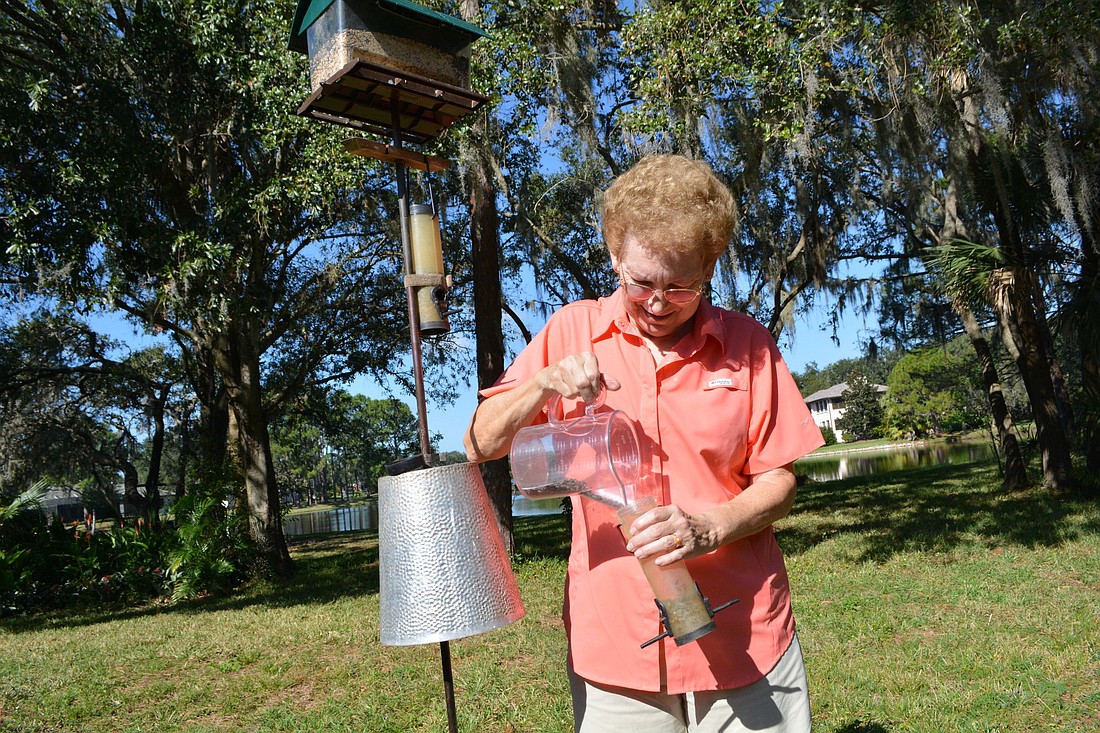- April 25, 2024
-
-
Loading

Loading

When Cindy Gordon moved from Maryland to Lakewood Ranch in 2005, one of her priorities included finding a home where she could feed and watch birds.
Her Country Club home in Lakewood Ranch proved the right fit.
“Coming from Maryland, we had a lot of birds that would be around all winter, and then other birds would migrate from other parts of the world and pass through,” Gordon said. “I made a list of probably 200 species that I either saw or had come to feeders. I learned to attract them with different types of food. Knowing what each type of birds prefer is the first thing you want. Birds are constantly looking for food.”
Overall, she said, birds are easy to attract, especially with a consistent supply of food. Water also is important.
In Lakewood Ranch, she has found that bird feeders will attract doves, finches, sparrows, cardinals and chickadees, and even some woodpeckers.
“But there are a lot of birds here that will not come to feeders,” Gordon said. “What you are attracting mostly are your songbirds. They appreciate a good supplement to their daily meal.”
Cardinals, in particular, like the black oil sunflower seeds — small black seeds, unlike the more common striped sunflower seeds. They also will eat finely cracked corn and millet.
Woodpeckers enjoy a dry suet, made by mixing Crisco, peanut butter and oatmeal or brown rice into a block and hanging it in a mesh laundry bag.
John and Susan Darovec, of Braden Woods, designed their yard with wildlife in mind, getting a designation from the National Wildlife Federation as a “backyard habitat.” Birds, Susan Darovec said, are bound to come if you have the right food supply.
“Keep the feeder there and be patient. They will come,” Susan Darovec said. “The water, when it’s dry like this, is huge.”
Keeping squirrels away from bird feeders can be a challenge, but there are solutions. John Darovec made his feeding station, a pole with two bird feeders up top and an upside-down metal trash can below it. The trash can, placed a few feet off the ground prevents the squirrels from jumping up onto to the feeder and stealing seed.
“You have to make sure its smooth,” he said of the can, adding he tried other buckets without success.
The type of seed used also can minimize squirrels’ attraction to feeders. For example, squirrels don’t like safflower or thistle seeds, Susan Darovec said.
Gordon adds variety to her daily bird viewing by keeping a flat, raised table in her backyard on which she puts seeds and nuts, as wells as scraps of meat and fat. For example, she’ll save fat from a roast and attract crows to the table for a snack.
“Make sure it’s fresh from night before, like a roast — not lunch meat with lots of salt,” she said. “They’re very fond of that, especially in the winter because the extra fat helps keep them warm.
“I find them very entertaining because they’re very smart. I like they’re calls. When I go out, they will call to me.”
Sometimes, she’ll also put out fresh fruit and berries, although not as many bird varieties pick on that offering.
When the seeds and scraps go bad, Gordon wipes it off to keep away unwanted critters.
Although they don’t put out meat scraps like Gordon, the Darovecs take other steps to give food to nonsong birds. They don’t use pesticides and prefer to attract bug-eating birds, such as Carolina wrens, warblers, blue-gray gnatcatchers and woodpeckers to serve as a form of pest control.
Both Gordon and the Darovecs agree that as nice as it is to have food for the birds, having a fresh supply of water is often more critical, especially during dry months. Both refresh their bird baths daily to keep the water fresh.
“Spanish moss works well to scrub out any (debris),” Susan Darovec said.
Certain types of plants, like coral honeysuckles, trumpet vine or a firebush plant, are hummingbird attractors that are grown easily in Florida.
The Darovecs prefer plants to the hummingbird feeder and have an arch in their front yard that’s covered in honeysuckle. They also have a field of heliconia, a tropical-looking plant with brightly colored flowers.